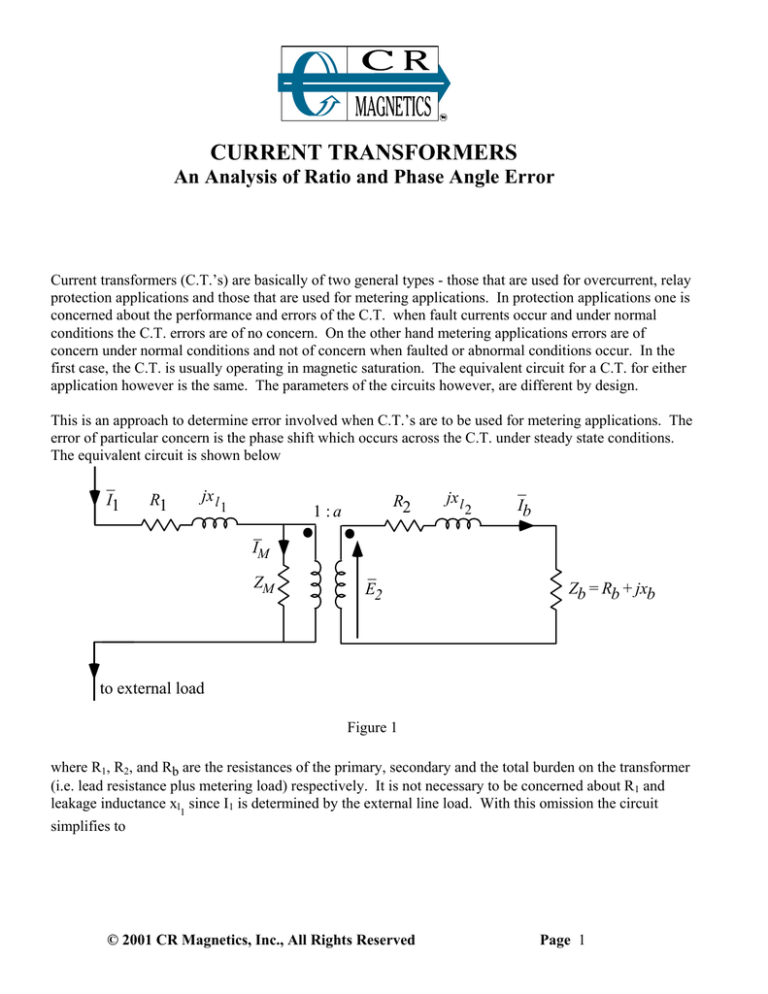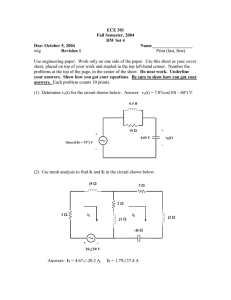CURRENT TRANSFORMERS An Analysis of Ratio and Phase Angle Error
advertisement

CURRENT TRANSFORMERS An Analysis of Ratio and Phase Angle Error Current transformers (C.T.’s) are basically of two general types - those that are used for overcurrent, relay protection applications and those that are used for metering applications. In protection applications one is concerned about the performance and errors of the C.T. when fault currents occur and under normal conditions the C.T. errors are of no concern. On the other hand metering applications errors are of concern under normal conditions and not of concern when faulted or abnormal conditions occur. In the first case, the C.T. is usually operating in magnetic saturation. The equivalent circuit for a C.T. for either application however is the same. The parameters of the circuits however, are different by design. This is an approach to determine error involved when C.T.’s are to be used for metering applications. The error of particular concern is the phase shift which occurs across the C.T. under steady state conditions. The equivalent circuit is shown below _ I1 R1 jx l 1 R2 1 :a jx l 2 _ Ib _ IM ZM _ E2 Zb = Rb + jxb to external load Figure 1 where R1, R2, and Rb are the resistances of the primary, secondary and the total burden on the transformer (i.e. lead resistance plus metering load) respectively. It is not necessary to be concerned about R1 and leakage inductance xl1 since I1 is determined by the external line load. With this omission the circuit simplifies to © 2001 CR Magnetics, Inc., All Rights Reserved Page 1 CURRENT TRANSFORMERS An Analysis of Ratio and Phase Angle Error _ I1 _ 1 : a I1' R2 _ E2 jx l _ Ib 2 _ Eb ' ZM _ IM' Z b = R b + jx b In the above circuits xl1, xl2 and xlb are the inductive leakage reactances of the primary, secondary, and burden reactances respectively. ZM is the magnetizing impedance the barred variables are indicative of phasor quantities. It is convenient to express primary quantities in secondary terms. Therefore current I′ I′ Z I1 = a1 and the magnetizing ZM becomes in secondary terms Z′M = M2 and IM = M a . a Np where a = N . s It may be helpful to draw the phasor diagram of the secondary circuit as it now appears by taking E2 as reference and noting I1′ = I M ′ + Ib _ E2 _ IM' _ Ib _ Eb _ Ib Z2 where: Z2 = R2 + jxl 2 _ I1' The angle between I1′ and Ib is the C.T. current phase shift. E2 = Ib Z2 + Eb = Ib R2 + jxx + Ib (Rb + jxb ) l2 © 2001 CR Magnetics, Inc., All Rights Reserved Page 2 CURRENT TRANSFORMERS An Analysis of Ratio and Phase Angle Error E2 = IM ′ ZM ′ also Note: Current phase shift between I1′ and Ib results because of the magnetizing current IM ′ . Normally the angle by which IM ′ lags the voltage across it (E2 ) is large. Example Calculation _ Assume a 250:5 C.T. ratio with a primary current of I1 = 150 0° Then: I1′ = 150 0° = 3 0° 50 for a= 5 250 By neglecting the primary leakage impedance as previously discussed and assuming the value of the secondary impedance as 0.03+j0.05 ohms, a total burden of 0.06 ohms and a magnetizing impedance ZM ′ = 7 + j10 referred to the secondary the secondary voltage E2 is then E2 = I1′ [R + jx [R + jx ][ ] 2 ′ + jXM ′ l2 + Rb RM 2 ′ + jx M ′ l2 + Rb + RM ] = I1′[0.03 + j 0.05 + 0.06][7 + j10] 0.03 + j0.05+ 0. 0 6 + 7+ j10 I ′[0.09 + j 0.05][7 + j10] I1′ [0.13 + j1.25] = = 1 7.09 + j10.05 12.66 56° = I1′ [0.099 31°] E2 = 3 0° [0.099 31°] = 0.297 31° from which: IM = 0.297 31° = 0.024 7 + j10 Ib = I1′ − IM = 3 0° − 0.024 − 24° − 24° = 2.995 0.03° © 2001 CR Magnetics, Inc., All Rights Reserved Page 3 CURRENT TRANSFORMERS An Analysis of Ratio and Phase Angle Error The phase shift between I1′ and Ib is 0.03° . The phase shift is determined by the magnetizing current IM ′ . If assume a new burden of 0.12 ohms for the same primary current of I1 = 150 0° 1.93 73.5° E2 = I1′ = I ′(0.15 18.9°) 12.33 54.6° 1 E2 = 0.45 18.9° 0.45 18.9° = 0.037 − 36.1° 12.2 55° Ib = 3 − I M = 2.971 + j0.022 = 2.97 0.424° IM = Note phase shift in current has moved to 0.424° . In practical cases Z′M does not remain constant because of magnetic saturation. Usually available are ′ . It is apparent from saturation characteristics as a plot of E2 as a function of the excitation current IM E these non-linear curves that ZM ′ = I 2 is not constant as Z′M is related to the slope of the excitation curve ′ M which is not constant and also a function of the C.T. ratio. For this reason one must include in the C.T. current phase shift calculations the non-linear saturation characteristic. To account for the non-linearity of ′ for the particular value of the ′ it is necessary to know the value of the secondary voltage E2 and IM ZM C.T. ratio taken off the excitation characteristic. The procedure here would be to plot the non-linear relationship on the excitation characteristic similar to what is done in non-linear electronic circuits the intersection of a “load line” defined by the non-linear characteristic is the operating point of the C.T. An example probably will be the best way to describe a solution to determine the phase shift which occurs. Example calculation: 1 . Assume a constant burden Assume a 250:5 C.T. ratio with I1 = 200A then I1 = 4A for a = 50 ′ is non-linear but the impedance angle of Z′M remains Zb = RB + jXB = 3 + j 0 Ω . Let’s assume ZM X constant at 70° that is tan −1 RM = 70° . The equivalent circuit is the same as before but ZM ′ is non-linear M © 2001 CR Magnetics, Inc., All Rights Reserved Page 4 CURRENT TRANSFORMERS An Analysis of Ratio and Phase Angle Error and not a constant magnitude. By assuming that the secondary leakage inductance is small compared to the burden impedance the calculations are easier with small error. however, if desired it can be included. By neglecting Z2 we then have Z′M in parallel with the constant burden Zb . The equivalent circuit can be considered to be driven by an ideal current source equal to the transformed primary current I1′ in this case 4A. The circuit now can be rearranged as follows with I1′ as a phasor reference. a _ I1' _ IM' Rb 4 0° _ E2 ' ZM jXb b The Thevenin equivalent circuit for terminals a - b is: _ I1' _ ETh jb = 3 + jo ETh = I1[Rb + jX b ] = 4 0°[3 + jo ] = 12 0° (This is the Thevenin equivalent voltage) a _ IM' Z 3 jo The Thevenin impedance is b = + 12 0° ' ZM b IM ′ = 12∠0° 12∠0° = Zb + ZM 3 + j0 + Z ′M ∠70° ′ © 2001 CR Magnetics, Inc., All Rights Reserved Page 5 CURRENT TRANSFORMERS An Analysis of Ratio and Phase Angle Error but E2 = IM ′ ZM ′ These two equations describe IM ′ and E2 which are the variables on the excitation characteristic. By now assuming magnitudes for ZM ′ . ′ we can plot the “load line” to obtain magnitudes of E2 and IM ′ IM ′ IM E2 0 4∠0° ∞ 20 0 0.566 0 12 11.32 M M M Let’s assume the magnetizing characteristic is of typical form given and the load line intersection the 250:5 characteristic at E2 = 11.32 and IM ′ = 0.566 . 12 X 11.32 300:5 250:5 200:5 E2 0.566 IM ′ 4 © 2001 CR Magnetics, Inc., All Rights Reserved Page 6 CURRENT TRANSFORMERS An Analysis of Ratio and Phase Angle Error Then we have I1′ = 4 0° E ZM ′ = 2 IM ′ = 11.32 0.566 = 20 12 0° = 0.566 − 62.3° 3 + 6.84 + j18.79 Ib = I1′ − IM ′ = 4 − (0.566 − 62 3. ° ) = 4 − (0.263 − j 0.5) = 3.74 + j0.5 IM ′ = = 3.77 7.61° Therefore the phase shift between Ib′ and Ib is 7.61°. This, of course, considers the saturation which occurs in the transformer. © 2001 CR Magnetics, Inc., All Rights Reserved Page 7


